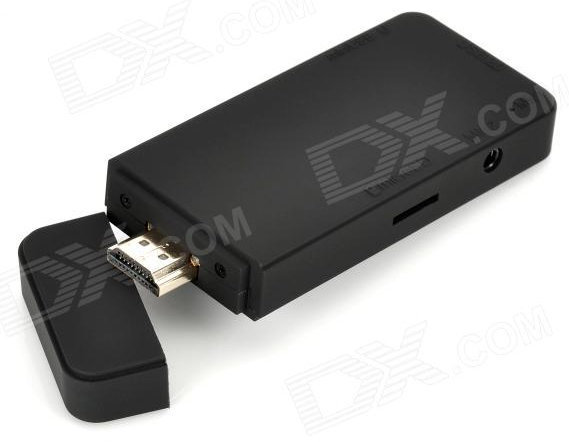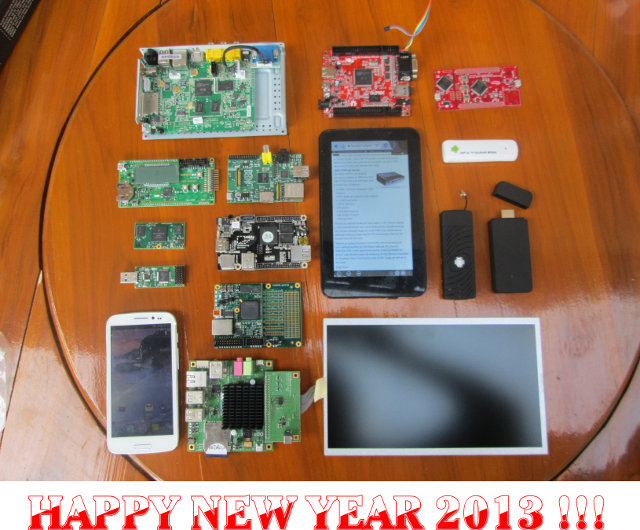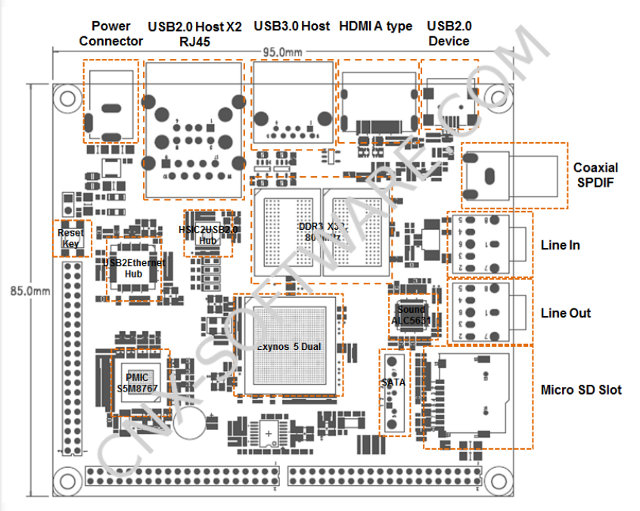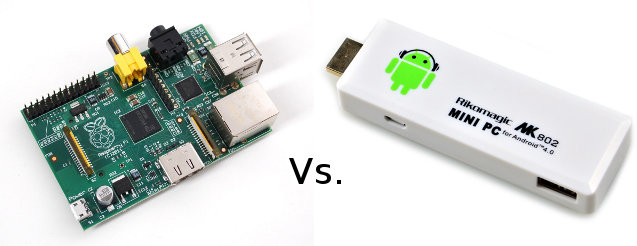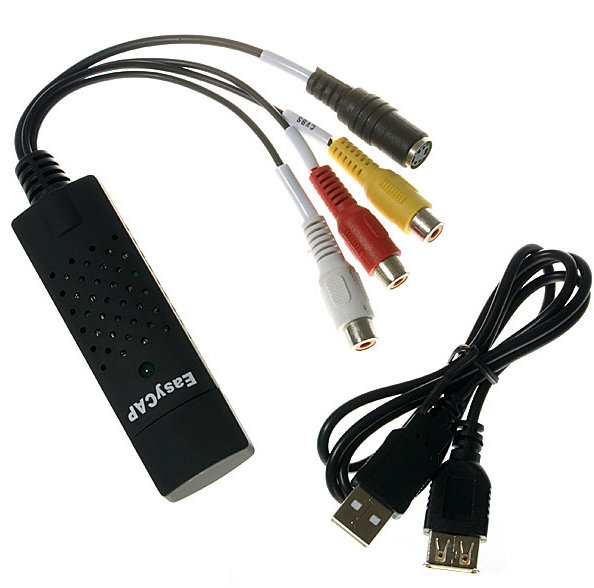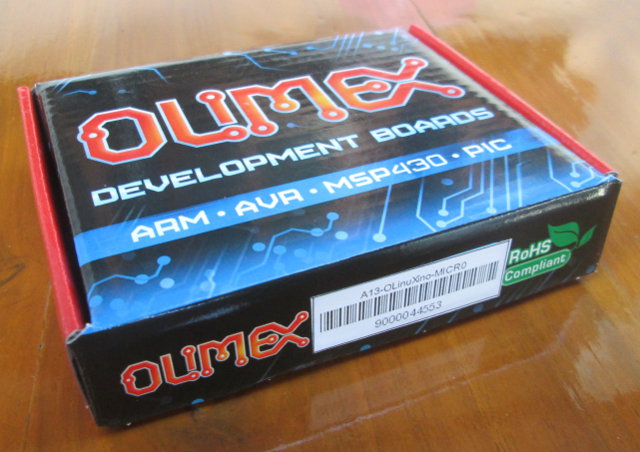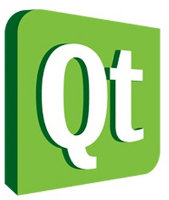Last July, I reviewed Smallart U-Host (U1A), an Android TV stick based on AllWinner A10 with 1GB RAM and 4GB RAM. At the time, I had a positive opinion of the device as the Android firmware was stable, and mostly did it was supposed, and it was feasible to run Linux distributions on the device. At that time, it was sold for $70, but this morning, Clint, one of my reader, informed me he spotted an AllWinner A10 device selling for $20.50 on Dealextreme. This device and the user interface resembles very much to Smallart U-Host, but the model name reported on Dealextreme is U2. According to Smallart U2 page, this device is based on Rockchip RK3066, so it’s just another naming mistake on DealExtreme. The rest of the specs are identical to Smallart U-Host: SoC – Allwinner A10 (Cortex A8) @ 1.5GHZ System Memory – 1GB DDR3 RAM Storage […]
Top 10 Posts of 2012 on CNXSoft Blog
This is the last day of the year, so it’s probably a good time to look back and see what interested people on this blog. This has been a banner year for low cost ARM devices and boards starting with the Raspberry Pi, then MK802 and the new mini PCs / HDMI TV dongles / PCs-on-a-stick (whatever you want to call them) that came after, always cheaper and faster. Those low cost devices have in turn made people really interested in ARM Linux, and lots of development on those little devices and boards started. The top 10 posts of 2012, according to page views, reflect just those trends: 74 USD AllWinner A10 Android 4.0 Mini PC (May 2012) – MK802 started the whole “low cost mini PCs” craze, and drove the most traffic to this blog this year. People got excited about the price, form factor, and the possibility to […]
$135 ARMBRIX Zero Exynos 5 Development Board Is Now Available for Pre-order
Ten days ago, I wrote about ARMBrix Zero, the cheapest Cortex A15 board (soon to be) available based on Samsung Exynos 5250 processor. It is now available for pre-order, and the company organizes a raffle to send a free ARMBRIX Zero board to the winner. I’ve received some updated specifications, although we don’t learn much more: CPU – Exynos 5 Dual ARM Cortex A15 Dual GPU – Mali T604 Embedded GPU Memory – 2GB DDR3 X32, 800MHz Storage – MicroSD slot Audio – ALC5631Q Line In/Out, SPDIF Coaxial type Video – HDMI A Type External Ports: 2x USB2.0 Host 1x USB3.0 Host 1x USB2.0 Device 1x SATA 1x Ethernet RJ45 Expansions – 3 Headers (Further details should be available later this week) CON16 – MIPI Master/Slave, 1x I2C, GPIO CON19 – 3x serial interfaces, 2x I2C, 2x ADC, JTAG, USB, MMC, and reset CON20 – I2S, Interrupt and GPIO pins, […]
MK802 II Mini PC Now Costs as Much as Raspberry Pi Model B. Let’s Compare Them!
MK802 mini PC quickly went viral as it launched in May 2012 for $74 US, and since then many Chinese manufacturers have jumped into the market bringing both new faster devices, and the price down. AllWinner A10s, a low cost version of AllWinner A10 used in MK802, was also launched specifically for this market to bring costs even lower. Today, I’ve been informed an HDMI TV dongle based on AllWinner A10s that sells for $36.55 on Tinydeal.com which is a very good price, but decided to check on Aliexpress to look for comparable deals, and found one shop selling MK802 II for $34.91 including shipping via China Post, which makes it cheaper than the Raspberry Pi model B selling for $35 excluding shipping. Both products target 2 different markets, as MK802 is oriented to the consumer market, and Raspberry Pi targets the educational market, but in practice, it appears people […]
$6.80 Easycap DC60 USB Video Capture Card
You may have some old VHS tapes that you want to digitize to play on your computer or media player, or don’t feel like spending money on an HD recorder for your satellite or cable TV box, but still would like to record your favorite programs. It’s actually possible to do so for less than $7 thanks to USB video grabbers. Those USB capture cards are nothing new, but I did not know the price had come down that much. One of the cheapest capture card is Easycap DC60 (clone?) that sells for $6.80 on Aliexpress, and runs on Windows, and (if you are lucky) in Linux. The device provides stereo audio input, composite input and S-Video input. It is sold with a USB cable to connect it to your computer. CD is normally provided with Windows drivers and program. All you need is a Windows 2000/XP computer with a […]
Olimex A13-OLinuXino-MICRO Development Board Unboxing And Review
Every Friday, Olimex organizes an online competition where they give away one of their board. They’ll ask a (usually simple) technical question on their twitter account at 22h00 (GMT+7), and all you have to do is to reply to their tweet with the correct answer within one hour. The winner is then selected randomly with random.org. There are usually 50 to 100 respondents so the odds are pretty good. I played a few times, and finally, I was lucky enough to win an A13-OLinuXino-MICRO development board at the beginning of December. I received it yesterday, after UPS took a whooping 15 days to deliver the board (Way to go UPS!). The board can be purchased on Olimex for 35 Euros plus shipping and taxes, or even lower if you order larger quantities. A13-OLinuXino-MICRO is a stripped down version of A13-OLinuXino-WIFI with the following specs: SoC – AllWinner A13 Cortex A8 […]
Linaro 12.12 Release with Linux Kernel 3.7 and Android 4.2.1
Linaro release 12.12 has just been announced, and includes Linux Kernel 3.7 and Android 4.2.1. The tracking version (stable release) uses Kernel 3.4.22. This release upgrades Android to version 4.2.1, Ubuntu images are now based on Ubuntu 12.10 (Quantal Quetzal) and Linaro U-Boot 2012.12 has been released with support for Origen 4 Quad and Arndale boards. Further improvements have been done for OpenEmbedded ARMv8, where they replaced the php Apache module by php-fpm among other things. On the kernel side, USB drivers have been refactored, and a kernel size analysis have been performed on several platforms. The power management team has mainly worked on big.LITTLE IKS and MP implementations, and it’s the first time LEG (Linaro Enterprise Group) is included in the release, and they worked on UEFI for ARM, GRUB for U-Boot, and provided a Ubuntu server image for Arndale board which can boot via UEFI or UBoot. Here […]
Digia and the Qt Project Release Qt 5.0
The Qt Project and Digia have announced the release of Qt 5.0, which is available via Qt 5.0 page on qt-project.org, or via qt.digia.com/qt5 for commercial customers. Qt 5.0 comes as a full SDK package including Qt 5 framework, Qt Creator 2.6.1, examples and full documentation. Qt 5.0 is available in source code and binary format for Linux (64 and 32 bit), Mac OS X (10.7 and 10.8), and Windows. You can read more about the main changes and new features compared to Qt 4.8, on my previous blog post about Qt 5 Alpha. A video showcasing some of the key features of Qt 5 has been uploaded to Youtube. The video above is actually a screen capture of a Qt 5 based application using Qt Quick, OpenGL and WebKit, running in a Mac. Audio has been added with iMovie application. You can try this Qt 5 Launch Demo by yourself by […]


